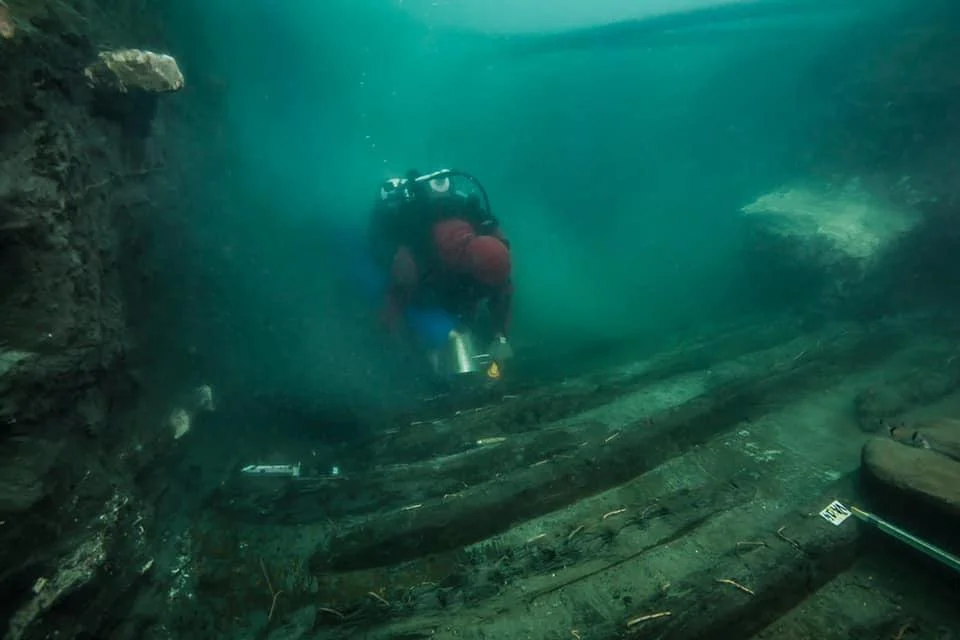2,400-Year-Old Baskets Still Filled With Fruit Found in Submerged Egyptian City
Wicker vessels recovered from the ruins of Thônis-Heracleion contain doum nuts and grape seeds

Researchers investigating the submerged metropolis of Thônis-Heracleion, in the Egyptian bay of Abū Qīr, have discovered wicker fruit baskets dated to the fourth century B.C.E.
Incredibly, the vessels still contain doum nuts—the fruit of an African palm tree considered sacred by the ancient Egyptians—and grape seeds.
“Nothing was disturbed,” marine archaeologist Franck Goddio tells Dalya Alberge of the Guardian. “It was very striking to see baskets of fruits.”
Goddio and his colleagues at the European Institute for Underwater Archaeology (IEASM) uncovered the containers in collaboration with Egypt’s Ministry of Tourism and Antiquities. Researchers have been surveying the ancient Mediterranean port city of Thônis-Heracleion since its rediscovery in 2001, according to Egypt Independent.
The baskets were stored in an underground room and may have been funerary offerings, reports the Greek City Times. Nearby, the researchers found a 197- by 26-foot tumulus, or burial mound, and an extravagant array of Greek funerary goods likely left by merchants and mercenaries living in the area.
“Everywhere we found evidence of burned material,” says Goddio in a statement, as quoted by CNN’s Radina Gigova. “Spectacular ceremonies must have taken place there. The place must have been sealed for hundreds of years as we have found no objects from later than the early fourth century B.C.E., even though the city lived on for several hundred years after that.”
Other objects found on or surrounding the tumulus included ancient pottery, bronze artifacts and figurines depicting the Egyptian god Osiris.
“We found hundreds of deposits made of ceramic,” Goddio tells the Guardian. “One above the other. These are imported ceramic, red on black figures.”
Thônis-Heracleion was founded around the eighth century B.C.E. According to Goddio’s website, the city served as the “obligatory port of entry to Egypt for all ships coming from the Greek world” prior to the establishment of Alexandria around 331 B.C.E.

The bustling trade hub reached its peak sometime between the sixth and fourth centuries B.C.E. Buildings radiated around a central temple, with a system of canals connecting different parts of the city. Homes and other religious structures stood on islands near the heart of Thônis-Heracleion.
Once an epicenter for maritime commerce, the city sank into the Mediterranean in the eighth century C.E. Some historians attribute the metropolis’ downfall to rising sea levels and collapsing, unstable sediment, as Reg Little wrote for Oxford Mail in 2022. Others posit that earthquakes and tidal waves caused a 42-square-mile segment of the Nile Delta to collapse into the sea, per CNN.
As the Art Newspaper’s Emily Sharpe reported in 2022, experts once thought that Heracleion—referenced by Greek historian Herodotus in the fifth century B.C.E.—was a separate city from Thônis, which is actually the site’s Egyptian name. A tablet found by Goddio’s team in 2001 helped researchers conclude that the two locations were one and the same.
Recovering objects from the ruins of Thônis-Heracleion is a grueling task due to the layers of protective sediment covering them.
“The goal is to learn as much as possible from our excavation without being intrusive,” Goddio told the Art Newspaper in 2022.
Previous discoveries at Thônis-Heracleion include more than 700 ancient anchors, gold coins and weights, and dozens of tiny limestone sarcophagi containing the remains of mummified animals, according to Oxford Mail. Last month, archaeologists found a well-preserved, second-century B.C.E. military vessel in a different part of the city.
Experts expect to unearth more artifacts at the site in the future. Speaking with the Guardian, Goddio estimates that just 3 percent of the sunken city has been studied in the 20 years since its rediscovery.
